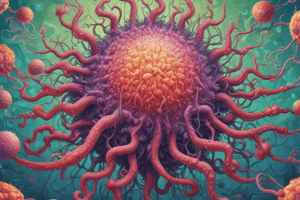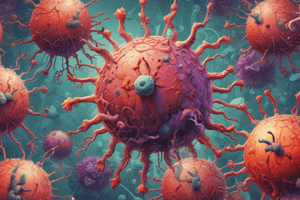Podcast
Questions and Answers
What is viral pathogenesis?
What is viral pathogenesis?
The process by which viruses cause disease
List the different modes by which viruses can be transmitted.
List the different modes by which viruses can be transmitted.
Direct contact, airborne transmission, vector-borne transmission, and contaminated surfaces.
What is Koch’s postulates?
What is Koch’s postulates?
A set of four criteria designed to establish a causal relationship between a microbe and a disease.
All infected individuals show signs of disease.
All infected individuals show signs of disease.
Why do Koch’s postulates not work for viruses?
Why do Koch’s postulates not work for viruses?
A nucleic acid sequence belonging to a putative pathogen should be present in most cases of an __________ disease.
A nucleic acid sequence belonging to a putative pathogen should be present in most cases of an __________ disease.
Match the following components of viral infections:
Match the following components of viral infections:
What are the stages of the virus life cycle in an individual cell?
What are the stages of the virus life cycle in an individual cell?
The disease caused by viruses is not influenced by the immune response of the host.
The disease caused by viruses is not influenced by the immune response of the host.
Fewer or no copy numbers of pathogen-associated nucleic acid sequences should be present in hosts without the disease.
Fewer or no copy numbers of pathogen-associated nucleic acid sequences should be present in hosts without the disease.
All virus infections result in clinical symptoms of disease in the host.
All virus infections result in clinical symptoms of disease in the host.
The same organism must be re-isolated from a healthy, susceptible host if the disease is to be reproduced.
The same organism must be re-isolated from a healthy, susceptible host if the disease is to be reproduced.
The modified Koch's postulates are applicable in situations where a suitable animal model for human disease is readily available.
The modified Koch's postulates are applicable in situations where a suitable animal model for human disease is readily available.
Successful virus infection requires local immune responses to be present and effective.
Successful virus infection requires local immune responses to be present and effective.
The respiratory tract is the most common route of virus entry into the host.
The respiratory tract is the most common route of virus entry into the host.
A sufficient amount of virus is necessary to initiate an infection regardless of host susceptibility.
A sufficient amount of virus is necessary to initiate an infection regardless of host susceptibility.
Viruses can enter the body through the outer surface of the eye without any breaches in the skin.
Viruses can enter the body through the outer surface of the eye without any breaches in the skin.
Once a virus has entered the bloodstream, it is always classified as causing a localized infection.
Once a virus has entered the bloodstream, it is always classified as causing a localized infection.
Flashcards are hidden until you start studying
Study Notes
Virology Course: MIC252
- Course instructor: Dr. Tasnim Suliman
- Contact email: [email protected]
- Textbook: Louten, J. Essential Human Virology, 2016, Elsevier. ISBN: 978-0-12-800947-5 (available free via UWC library)
Lecture 26: Viral Pathogenesis
- Covers how viruses enter the body, spread to other organs, and cause disease.
- Explains how viruses cause disease.
- Explains how viruses enter the human body.
- Describes how viruses spread in the human body.
- Lists different modes of virus transmission.
- Explains how Koch’s postulates are modified for viruses.
- Textbook reading: Essential Human Virology, Chapter 5 (sections 5.1, 5.2, 5.3).
Virus Characteristics
- Very small (10-400 nm).
- Infectious.
- Obligate intracellular parasites.
- Genetic material: RNA or DNA.
- Protein capsid, sometimes a membrane.
- Lack protein synthesis machinery; cannot reproduce independently. Not cells; not bacteria.
Koch's Postulates (and their limitations for viruses)
- Four criteria to establish a causal relationship between a microbe and a disease.
- Organism consistently associated with the disease and its lesions.
- Organism isolable and culturable from the diseased host.
- Disease reproducible by introducing a pure culture into a healthy host.
- Same organism reisolable from the experimentally infected host.
- Limitations: Many viruses don't cause disease in every infected individual; different viruses can cause the same disease; many viruses are not culturable; suitable animal models for human disease are not always available.
Modified Koch's Postulates (for Viruses)
- A putative pathogen's nucleic acid sequence should be present in most disease cases.
- Fewer or no pathogen-associated nucleic acid sequences should be in healthy hosts/tissues.
- Pathogen nucleic acid copy numbers should decrease/be undetectable as disease resolves, and increase with relapse.
Viral Pathogenesis and Disease
- Viral pathogenesis: the process by which viruses cause disease.
- Viral disease is influenced by both viral and host genes (replication effects and host immune response).
- Many virus infections are asymptomatic or subclinical (the immune response controls the infection, no disease).
- Some viruses block the immune response, leading to more severe disease. The immune response itself can sometimes be responsible for symptoms.
Cycle of Virus Infection
- Entry... (Further details to be covered in subsequent lectures).
Koch's Postulates and Their Modification
- Koch's postulates outline criteria for establishing a causative link between a microbe and a disease. These include consistent association, isolation, reproduction of disease in a healthy host, and reisolation from the experimental host.
- These postulates are not always applicable to viruses, as some viruses cannot be cultured, and different viruses can cause similar diseases. There may also be asymptomatic infections.
- Modified Koch's postulates for the 21st century focus on the presence and changes in the copy number of pathogen-associated nucleic acid sequences during infection and recovery.
Viral Pathogenesis and Disease
- Viral pathogenesis is the process by which viruses cause disease.
- Viral disease results from both viral replication and the host's immune response. Viral and host genes influence disease development.
- Many viral infections are subclinical or asymptomatic due to effective host immune control. Some viruses evade the immune system, leading to severe disease; sometimes, the immune response itself causes symptoms.
Cycle of Virus Infection
- Virus infection involves entry into the host, spread to secondary sites (localized or disseminated/systemic), and shedding.
- Viral spread can occur locally, via lymphatic, neuronal, or blood (viremia) routes.
Successful Virus Infection
- Three factors determine successful viral infection: sufficient virus for initiation, accessible and susceptible (entry) and permissive (replication) cells at the infection site, and initially ineffective local immune responses.
Viral Entry Sites
- Common virus entry points include the respiratory tract, alimentary tract, urogenital tract, outer eye surface, and skin (requiring a breach).
Respiratory Tract Infection
- The respiratory tract is a common entry route, with viruses entering via aerosolized droplets from coughs or sneezes.
- Host defenses include mucus trapping, ciliary action, and alveolar macrophages.
Alimentary Tract Infection
- The alimentary tract is another entry point through ingestion.
- The gut's hostile environment (low stomach pH, high intestinal pH, digestive enzymes) restricts the types of viruses that can survive and infect.
Viral Spread
- Viruses can remain localized or spread to other tissues.
- Disseminated infection extends beyond the primary site, while systemic infection involves many organs.
- Directional virus release from polarized cells influences whether an infection remains localized or becomes systemic, depending on whether the virus is released apically (localized) or basally (disseminated).
Viral Spread Through Blood
- Viremia involves infectious virus particles in the blood.
- Viruses spread from local sites to the blood via the lymphatic system, either free or within infected immune cells (e.g., HIV).
- Primary viremia occurs initially, with a low viral load, while secondary viremia follows dissemination to other organs and shows a high viral load.
Viral Spread Through Neurons
- Some viruses (neurotropic viruses) spread via nerve endings, including neuroinvasive (entering the CNS) and neurovirulent (causing neurological disease) viruses. Examples include rabies and herpes viruses.
Organ Invasion
- Viruses in the bloodstream can invade organs, crossing blood vessel/tissue barriers causing various manifestations (skin rashes, hepatitis, encephalitis, myocarditis, or congenital infections).
Virus Tropism
- Most viruses exhibit cell-type (cellular tropism) and organ (tissue tropism) specificity.
- Tropism depends on the presence of entry receptors and cellular proteins supporting viral replication.
Virus Transmission
- Virus transmission involves direct (close contact, droplet spread) and indirect (airborne, vehicle-borne, vector-borne) routes.
Additional Virology Resources
- Several websites and podcasts are listed as resources for further learning about virology. These include a podcast about viruses, a viral zone database, and public health organization websites (WHO, CDC, NICD).
Studying That Suits You
Use AI to generate personalized quizzes and flashcards to suit your learning preferences.




